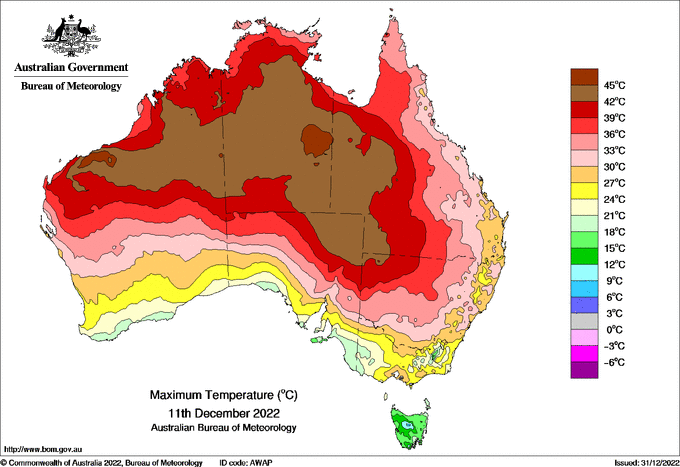- Northern Australia experienced extreme temperatures during December, with mid to high 40s in many locations.
- The extreme temperatures are unusual for tropical regions.

The northern parts of Western Australia, the Northern Territory and Queensland experienced a prolonged heatwave during the first fortnight of December 2022. At the same time, south-eastern Australia was recording cold and wet conditions, with a series of cold fronts bringing showers, winds and snow in some alpine areas. A record low summer temperature of -7°C was recorded at Perisher in the early hours of the 9th of December.
On the 7th of December, Marble Bar in Western Australia’s Pilbara region was the hottest place in the world, reaching 46.2°C. The preceding three days had seen temperatures in excess of 45°C at this location. Several other locations in the Northern Territory and Queensland were in the top 20 hottest temperatures in the world on that day.
The heatwave was fuelled by a lack of weather conditions which have a “cooling” effect in this region. A period of suppressed tropical activity, resulting in dry air and clear skies, allowed the heat to build. During this “monsoon break”, the usual north-westerly winds, which help to keep temperatures down, did not arrive over northern Australia. The negative Indian Ocean Dipole, which increases cloud across northern Australia, returned to neutral conditions with the index showing neutral values for five consecutive weeks. The reduced cloud cover allowed more heat from the sun to reach the land surface. The sea breeze was also weakened due to extremely warm sea surface temperatures, particularly around the Gulf of Carpentaria and Coral Sea, where spring ocean temperatures were the warmest on record.

The heatwave followed a cooler, wetter period over eastern Australia. People take time to acclimatise to the heat, and so health impacts from extreme heat are worse early in the warm season. Heatwaves are one of the most significant natural hazards in Australia in terms of loss of life. For this reason, the Bureau of Meteorology considers recent temperatures in heatwave alerts. Heatwave conditions are expected to continue to worsen as the climate warms. The ARC Centre of Excellence for Climate Extremes is continuing to research links between heatwaves and weather systems, soil moisture and climate change.
Main research contact: Dr Tess Parker | Tess.Parker@monash.edu
The State of Weather and Climate Extremes 2022
Weather and climate extremes in Antarctica
Extreme events in 2022
Heatwaves in Western Australia
Extreme rainfall and flooding in Queensland and New South Wales February-March 2022
Record low Antarctic sea ice extent in 2022
Simultaneous Antarctic and Arctic heatwaves
Collapse of East Antarctic Conger ice shelf
Hailstorms in Queensland, Victoria and New South Wales
Damaging wind gusts in South Australia and the Northern Territory
© 2023 ARC Centre of Excellence for Climate Extremes
References and acknowledgements available in the PDF version available here.
Materials used are for educational purposes and either author provided or used under fair dealing provisions.
